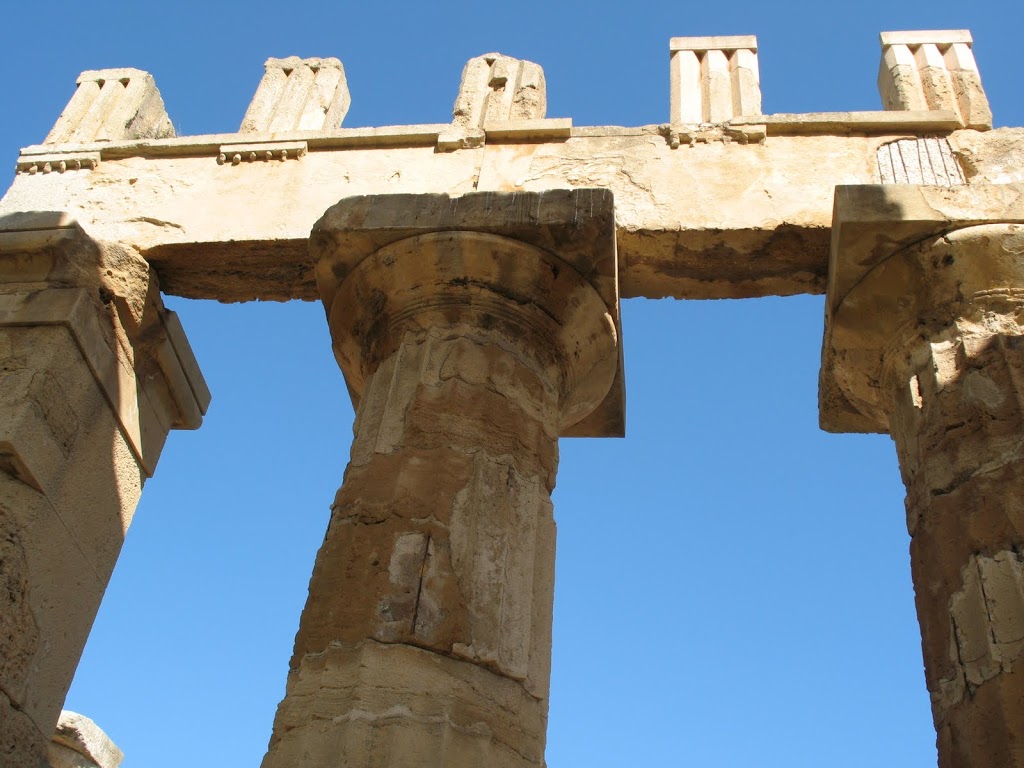 In Selinunte, Sicily, the remains of several Greek temples from the 6th- 5th century BC reveal much about temple construction, although they fell to Carthaginian invasions and earthquakes not long
In Selinunte, Sicily, the remains of several Greek temples from the 6th- 5th century BC reveal much about temple construction, although they fell to Carthaginian invasions and earthquakes not longafter their building. Temple E has most of its outer colonnade, the peristyle, restored.Classical harmony is apparent in the rhythm of fluted columns, continuing up into the triglyphs raised to the sky.
Architect Mark Schara, with his good eye for detail, took almost all of these photos.
Architect Mark Schara, with his good eye for detail, took almost all of these photos.
.
Temple F was badly damaged. Much of the white stucco facing for the fluted limestone column on right is still visible.
Tem
ple G, below, was the largest of the 7 temples of Selinunte, the ancient city of Silenus. This temple had columns about 54 feet tall. Here, we see the columns were made of individual segments called drums, each of which are 12 feet high.
This temple had columns about 54 feet tall. Here, we see the columns were made of individual segments called drums, each of which are 12 feet high.The overturned capitals, echinus on top of the abacus, has an 11′ diameter. Here, the abacus and echinus were carved in one piece, unlike above at Temple E.
At the time of destruction, not all of the capitals had been fluted. Thus we
know that the temple was never completed
know that the temple was never completed
Nearby in Agrigento, the ancient city called Akragas, had a series of ten te
mples in the Valley of the Temples.
The Temple of Concord is one of the best preserved Doric temples.
It had been converted into a church in the early Christian period.
In the 8th -3rd centuries BCE, Sicily was a battleground between Greeks who settled 3/4 of the island and Carthaginians who settled the western portion; then it became the target of Roman conquest.
 Though only a small portion of the peristyle remains, the
Though only a small portion of the peristyle remains, the
Temple of Hera was in better condition than most of these temples
which fell victim to Carthaginian destruction, then earthquakes.
But an even taller temple to Olympian Zeus would have been the largest of
Doric Greek temples, the height of a 10-story building; it was incomplete when the disaster struck. Construction began in 480 BCE and was still in progress when it was decimated in 407 BCE. The Telemon or Atlas figures whose bent arms support the architravemay in fact represent Carthaginian prisoners who had been made to build the temple.
Construction began in 480 BCE and was still in progress when it was decimated in 407 BCE. The Telemon or Atlas figures whose bent arms support the architravemay in fact represent Carthaginian prisoners who had been made to build the temple.  But even these giants, who appear to have held up the building, have fallen,
But even these giants, who appear to have held up the building, have fallen,struck down by the Carthaginians who conquered Akragras.
Only a replica of one of the ruined giants remains on the site.
 Ancient Akragas may have had 200.000 people in the 5th century BCE.Today we witness the fallen giant as a symbol of human pride grown too large,
Ancient Akragas may have had 200.000 people in the 5th century BCE.Today we witness the fallen giant as a symbol of human pride grown too large,and, consequently, fallen.





Beautiful photos !! Sicily's is a historic treasures, also it's impressive archeological site.
After visiting Selinunte and marveling at the scattered ruins of the temples, I am awestruck at the magnificent well preserved Temple of Concord, perched on the hillside. As you remember, I had the good fortune to work some days at the Marsala archeological museum where a lot of Punic, Roman and Medieval artifacts are stored. We also made a side trip to Mozia, which later became an important naval base and landing site for the Carthagininians who set about conquering the island and ransacking sites like Selinunte and Agrigento.
The fondest memories I have are of meandering through the acropolis at Selinunte and imagining life as it must have been bak then. Unlike Agrigento, the surroundings views at Selinunte of the Mediterranean are less developed and unobstructed. After a long day of walking through the ruins at Selinunte we ended up sitting and resting on one of the ancient walls looking out onto a beautiful, unspoiled view of the ocean.
Thanks for bringing back these memories.
JL